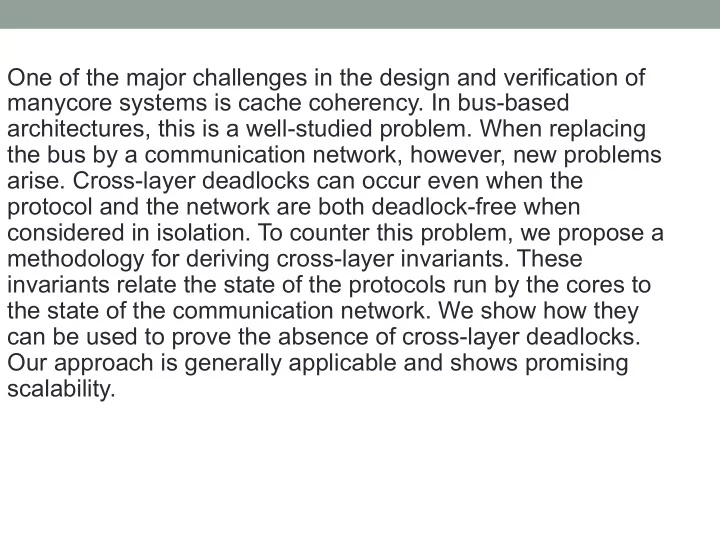

One of the major challenges in the design and verification of manycore systems is cache coherency. In bus-based architectures, this is a well-studied problem. When replacing the bus by a communication network, however, new problems arise. Cross-layer deadlocks can occur even when the protocol and the network are both deadlock-free when considered in isolation. To counter this problem, we propose a methodology for deriving cross-layer invariants. These invariants relate the state of the protocols run by the cores to the state of the communication network. We show how they can be used to prove the absence of cross-layer deadlocks. Our approach is generally applicable and shows promising scalability.
CROSS-LAYER INVARIANTS FOR NOCS Freek Verbeek, Pooria Mohammadi Yaghini, Ashkan Eghbal and Nader Bagherzadeh
Cache Coherence & Singlecore
Cache Coherence & Multicore edacafe.com
✖ = req u = ack
✖ ✖ = req u = ack
✖ = req u = ack
u ✖ = req u = ack
✖ = req u = ack
Deadlock? ✖ = req u = ack
Deadlock? ✖ ✖ u u ✖ = req u = ack
Example: cross-layer deadlock
Example: cross-layer deadlock
Example: cross-layer deadlock get
Example: cross-layer deadlock
Example: cross-layer deadlock inv
Example: cross-layer deadlock put inv
Example: cross-layer deadlock inv ack
Deadlock Detection 1. Model protocol + interconnect 2. Overapproximate deadlocks 3. Use invariants to rule out unreachable deadlocks 4. Use SMT solver to prove deadlock-freedom or find possible deadlock
1.) Overapproximate deadlocks ∨ s 0 ∧ # q 0 = q 0 . size ∧ t 1 ∧ # q 1 = q 1 . size s 1 ∧ # q 1 = 0 ∧ t 0 ∧ # q 0 = 0 ∧
2.) Derive invariants
3.) Use SMT solver ∨ s 0 ∧ # q 0 = q 0 . size ∧ t 1 ∧ # q 1 = q 1 . size s 1 ∧ # q 1 = 0 ∧ t 0 ∧ # q 0 = 0 ∧ ∨
Case Study: 2D mesh, XY routing, MI cache coherence protocol Interconnect:
Case Study: 2D mesh, XY routing, MI cache coherence protocol Protocol: L2 caches Directory
Case Study: 2D mesh, XY routing, MI cache coherence protocol Router MI Cache Core Router MI Directory Core
Experimental Results
Case Study: 2D torus with ring, XY routing, snoopy cache coherence protocol Interconnect: Protocol:
Experimental Results
Deadlock Detection 1. Model protocol + interconnect 2. Overapproximate deadlocks 3. Use invariants to rule out unreachable deadlocks 4. Use SMT solver to prove deadlock-freedom or find possible deadlock
Modelling … … the interconnect ... the protocol • xMAS • IO automata • graphical language • events and transformations • formal semantics: • formal semantics: trdy/irdy/data signals trdy/irdy/data signals
Semantics
Invariant Generation 1. The sum of firing ingoing transitions equals the sum of firing outgoing transitions. Example:
Invariant Generation Let be a partitioning of all pairs such that:
Invariant Generation 2. The sum of incoming packets equals the number of times a transition fired that consumes such a packet. Example:
Conclusion • Methodology for finding cross-layer deadlocks • Makes use of cross-layer invariants • Monolithic verification of protocol and interconnect • generic w.r.t. interconnect • generic w.r.t. protocol • Fully automated • Haskell implementation of invariant generation, deadlock detection, and various required paraphernalia
Recommend
More recommend